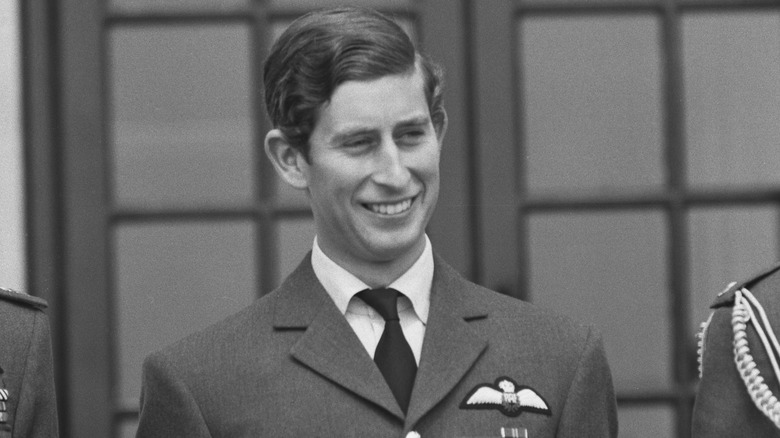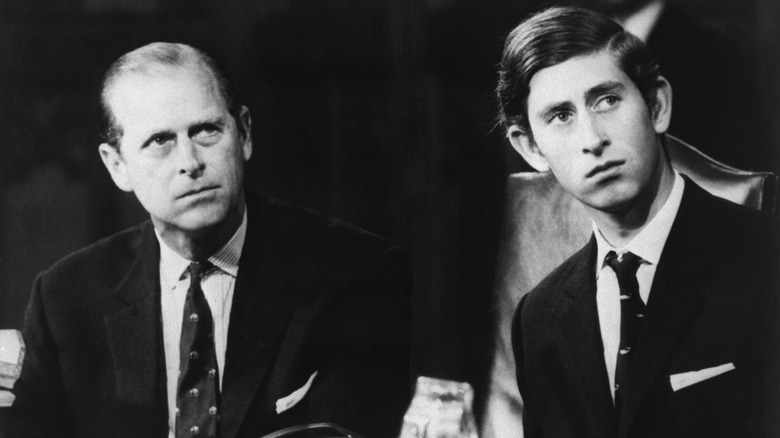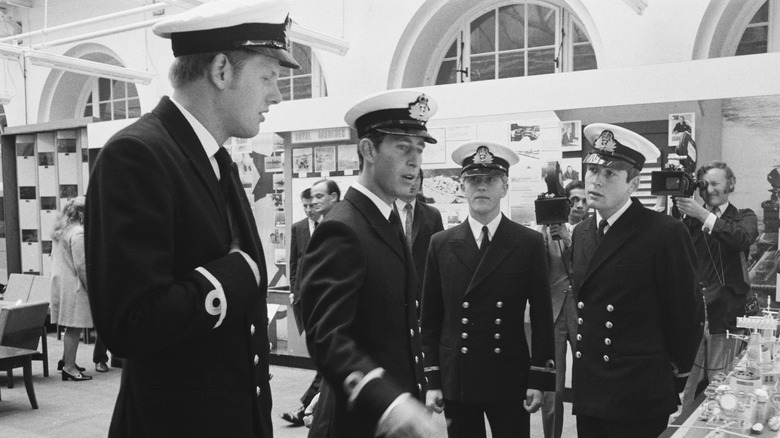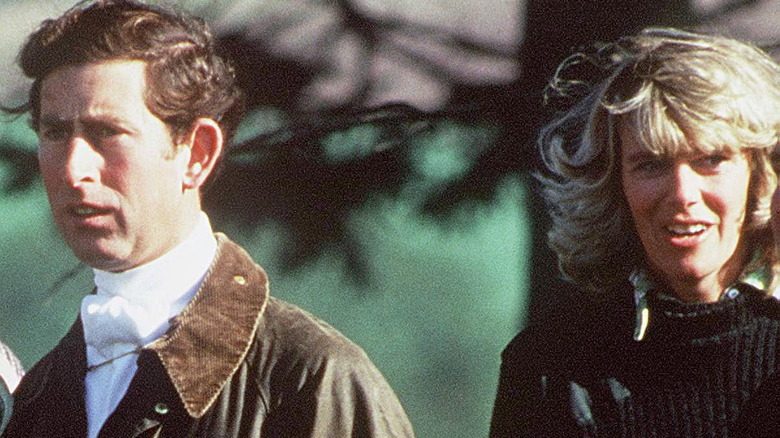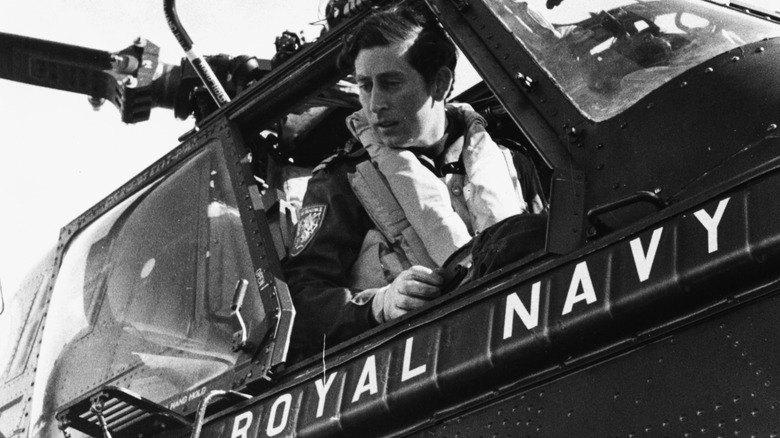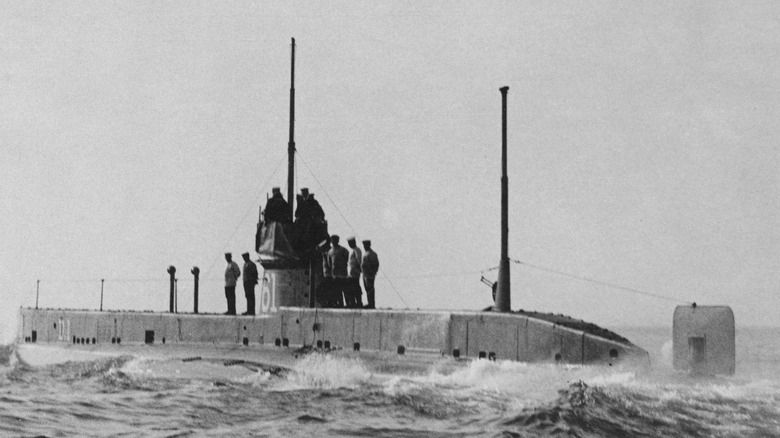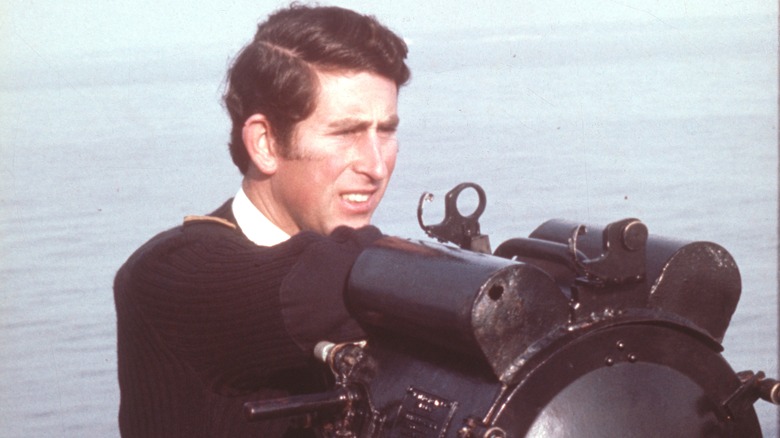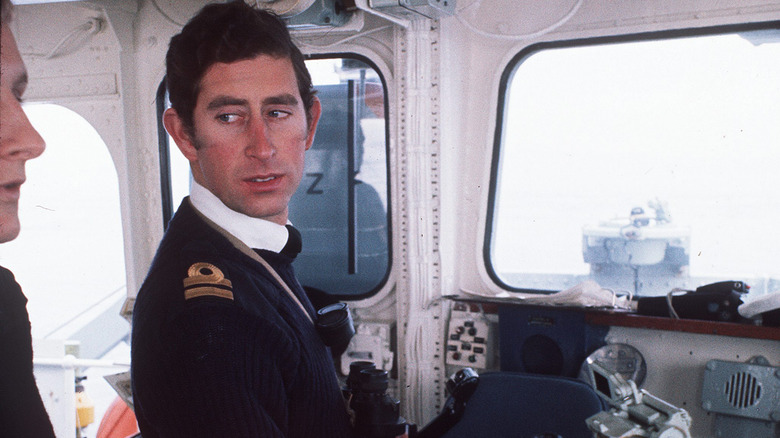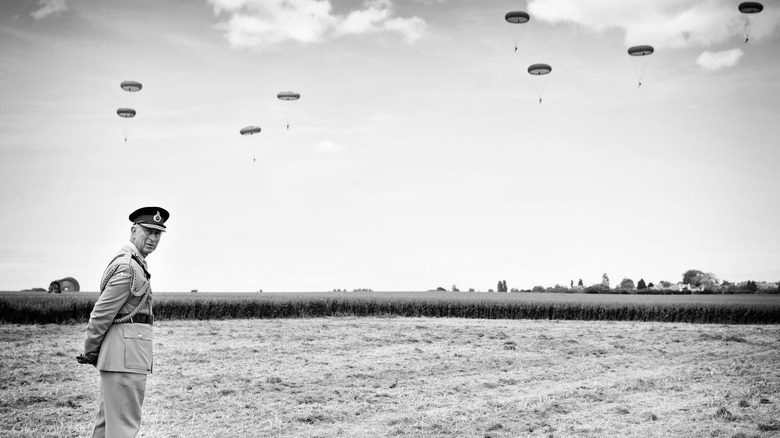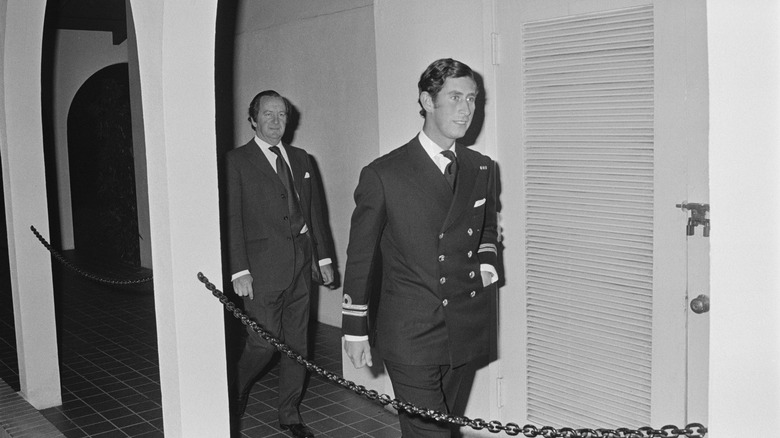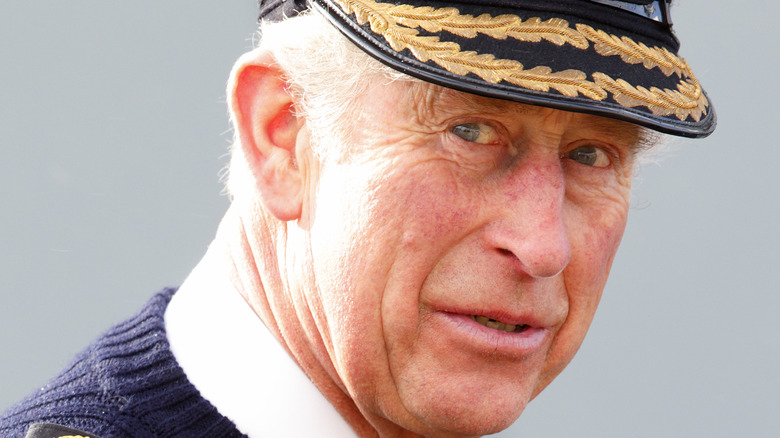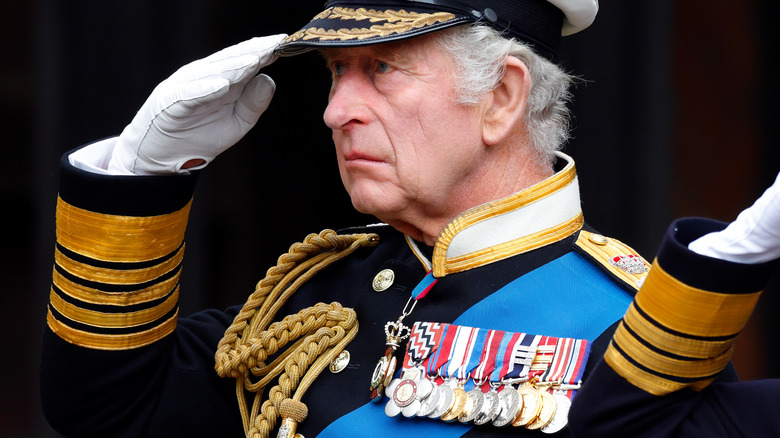What King Charles' Time In The Military Was Really Like
While there is no hard and fast rule that says British royals have to serve in the military, it's generally expected of the senior males of the family. For centuries, royals have been joining the ranks of the British forces — whether it be to lead their troops into war on horseback or otherwise assist in war efforts. King Charles III was no exception. The current sovereign did his duty when he was a youngster, enlisting in in the Royal Navy and the Royal Air Force in 1971, but what was his time in the ranks really like?
It's common to think that Charles had it easy given his station as future king, but a member of the forces is a member of the forces. Regardless of their lineage, they're expected to do their duty just like everyone else. Charles' stint came at a time of political unrest in the world, just prior to the Falklands War and in the middle of the Cold War. Tensions may have been rife, but Charles was also experiencing a time of personal turmoil.
Perhaps Charles welcomed the routine and structure of military life if only to distract him from his lifelong duties to the crown — even for a brief moment in time. It wasn't always an easy vocation for the future sovereign, though. From a failed first parachute attempt to a gaffe that cost the Navy a fortune, let's take a look at what Charles' time in the forces was really like.
His decision to join the Navy was based on his father
Serving his country in some capacity was a no-brainer, but which force? King Charles III could have chosen to join the Royal Marines, the army, or some other unit, but to him, the choice was obvious. Charles enlisted in the Navy just as his father and grandfathers before him had. Prince Philip's relationship with the Navy was famous in itself, as he first became involved in the historic institution when he was a student at Britannia Royal Naval College in Dartmouth, Devon. It was there that he met his future wife, Queen Elizabeth II (then Princess Elizabeth). Philip rose up through the ranks of the Navy, holding titles such as Lieutenant Commander, Admiral of the Sea Cadet Corps, and Captain General of the Royal Marines.
It's likely Charles felt some pressure, be it great or small, to live up to his father's impressive legacy. Tradition meant a lot to Philip, who famously pressed for his son to go to Gordonstoun, the same bleak Scottish private school that he attended as a youngster. Had Queen Elizabeth II had her way, Charles would have been an Eton boy. The monarch would go on to serve for five years before leaving the Navy, unlike his father who stayed with the institution for almost 14 years. Of course, circumstances were different, with Philip never having been in line for the throne.
He wasn't treated any differently from other recruits
Joining the ranks of any military institution isn't easy, especially in the beginning. Navy training is vigorous and done in two phases, one is a 10-week stint at HMS Raliegh, where the Royal Navy claims "you'll be put to the test both physically and mentally while getting your first proper taste of what life in the Royal Navy is like — and what's expected of you." It's not for the faint of heart, with recruits expected to join in peak physical fitness. You might think that Charles got to skip some of the basic training, but this wasn't the case. He was taught the same things as the other men and had to log all of his activities, just as they did.
However, thanks to his flight training with the RAF at university, Charles was able to hop ontothe accelerated graduates course, meaning his training took a little less time than usual (but only slightly). The Royal Navy asserted on its website, "Though heir to the throne, he learned about the basics of life at sea like any other officer under training, maintaining a thorough log of all activities. Unfortunately, Norfolk's program was not especially exciting: a visit to Toulon followed by maintenance." For Charles, the first year at sea largely consisted of getting to know how life operated on a vessel, especially during the Cold War-era of unrest and uncertainty.
He dealt with heartbreak while he served
Adjusting to life at sea after living most of his life in top-notch palaces and private schools wouldn't have been an easy task for the then-prince, but there was more to it than that. King Charles III and Camilla, Queen Consort, were able to achieve a happy end to their romance eventually, but for many years their marriage didn't even seem like a remote possibility. The pair first dated in 1970, before the relationship was called off when Charles went into the Royal Navy. The royal family didn't approve of Camilla as a suitor to Charles because she was deemed an "experienced" woman when the future king apparently needed someone more innocent to be the future queen. When Camilla married Andrew Parker-Bowles in 1973, Charles was said to be devastated.
Biographer Sarah Bradford claimed in her book, "Diana", that Charles remained besotted with Camilla even after she was taken off the market, describing an incident at a party some years later: "The physical passion of Charles for Camilla was obvious to everyone." Their complicated connection was obviously built to last, but in the early days, Charles was left to watch her move on and build a life of her own while he toiled away at sea. Breakups are tough in the best of times, but being separated by duty and not a lack of love must be especially awful. Thankfully for Charles, the military gave him plenty to be distracted with.
Charles became a skilled pilot
Although ships were one thing and likely always in the cards for King Charles III, the young future king decided not to limit himself. Not only had he spent some time training with the RAF and learning how to fly planes during his Cambridge years, but he also learned how to fly a helicopter. After spending a few years getting his sea legs aboard HMS Minerva and HMS Jupiter, Charles decided it was time to take to the skies once more to get his chopper license.
A reporter from news station ITN was there at Royal Naval Air Station in Yeovilton, Somerset, when Charles climbed into the helicopter for his very first lesson, stating, "It's the start of a three-and-a-half month flying course, at the end of which he'll be qualified, like his father Prince Philip, to fly helicopters, including those belonging to the Queen's Flight." Of course, he passed with flying colors and it wasn't long before he took what he learned back to the Navy. He returned to the sea as part of the 845 Naval Air Squadron on HMS Hermes. If anything, this goes to show that Charles was — and is — more than capable of turning his hand to many different things, from flying helicopters to setting up charitable trusts and navigating one of the stormiest journeys of all — his turbulent divorce from Princess Diana.
Charles trained vigorously for underwater warfare
Though he may never have been sent to war, there were several things going on while he was in the military that meant King Charles III had to be prepared for every possibility or eventuality. The future monarch had to be prepared to do his duty alongside his fellow seaman. Among many other skills Charles gained during his time in the Royal Navy, he trained for underwater warfare. In the event of a submarine attack, Charles would have known exactly what to do. While he didn't see conflict, he was more than ready to serve his country should the day ever come.
As you might expect, underwater warfare is no joke. Submarines are complicated vessels that are key in keeping territories secure, which is why millions and millions of dollars are spent on their development. As for the servicemen who operate them, like Charles, they're highly skilled at working with advanced computer systems, being able to identify and track potential threats, and knowing what action to take if the enemy advances. By the time he joined the Royal Navy, Charles was used to following strict orders as a member of the royal family. This lifelong practice likely put him in good stead for his training.
Charles was a good officer despite struggling with seasickness
Every member of any battalion, squadron, or otherwise will likely experience some nerves when signing up and performing their duty, but what happens when you throw in serving alongside a member of the royal family?
Working with the then-future king of England was something incredibly memorable for a lot of the other recruits, so it's hardly surprising that they have some tea to spill. One fellow seaman claimed King Charles was incredibly funny, telling the Royal Navy about an incident during "a fascinating lecture on boiler water testing during which Prince Charles kept us in stitches with a string of jokes."
Charles clearly had a sense of humor in his work, which his colleagues loved about him. After all, being cooped up on ships and submarines can be grim at times. That wasn't all that they had to say about him, though. Another man, Petty Officer John Friar, was under Charles' command when he took control of HMS Bronington towards the end of his time in the military. He explained to Royal Navy: "[He was] without doubt, the best ship handler by far. Believe me, if he had been rubbish, I would say so. He was not a good sailor in that he got very seasick, but then again, so did Nelson." Despite his multiple years at sea, it seems that Charles never quite found his legs — but it didn't stop him from being a fine officer.
He played an important Cold War role
By the time King Charles III joined the Royal Navy, the Cold War had been raging on for decades. The struggle, which saw tensions rise between the United States and the Soviet Union, wasn't a pretty affair, with many feeling it could erupt into a full-scale conflict. While Charles didn't end up needing to engage in combat, he still played an important role.
"If there had been a war with the Soviet Union, we knew the Soviets had thousands of mines and they would have used them prolifically," Admiral Lord West told Forces News. "And to keep the routes open into our ports, bearing in mind 95% of all the goods coming to this country come in by sea, they could only be kept open if we could keep the seabed clear and keep it clear of mines. And so these little tiny ships were really, really important." West continued, saying, "What Prince Charles was doing, even that tiny role, this was crucial stuff to show a capability that we had."
Charles would have been very aware of how vital his job was, given how seriously he has taken any role given to him in his life. The admiral went on to say that Charles always had a queue of marines wanting to go in the helicopter he piloted because it was "absolutely better maintained than any other helicopter on board."
His first parachute jump left something to be desired
King Charles may be the Colonel in Chief of the Parachute Regiment, but that doesn't mean he's always been great at jumping out of planes. It seems like the monarch has taken pretty swiftly to learning new skills in the past, but this wasn't an immediate fit. In a speech given to the Parachute Regiment at Merville Barracks in 2021, Charles was entirely candid about his first experience.
"I find it hard to believe that it has been 44 years since I became your Colonel in Chief and nearly 50 years since I made my first parachute drop — initially upside down with my legs in the rigging lines into Studland Bay in Dorset, where I was pulled out of the water by the Royal Marines," he admitted. Thankfully, he managed to get out of it unscathed, otherwise, the future of the monarchy might have looked very different indeed!
A costly gaffee saw him wear a toilet seat around his neck
After working his way up through the ranks, King Charles III was eventually given command of his own vessel in the Royal Navy, taking control of HMS Bronington in 1976. That new responsibility didn't stop him from making a mistake that cost the Navy a good amount of cash, though. A former crew member explained the situation in the 2015 documentary, "Charles, Prince of Wales: A Life of Madness," saying, "When we came to anchor up in the morning to move as a squadron, Prince Charles pulled his anchor up to find the truss channel telephone cable was hooked on the flukes of his anchor. They spent a long time trying to get rid of that cable." He continued, saying, "Finally they had to ditch one and a half shackles of phosphor-bronze chain, which is probably the most valuable thing that naval minehunters carry."
Though it could be said it wasn't entirely Charles' fault, the Royal Navy reportedly gave the royal servicemen a rough time over it. A few short months later, Charles retired from active duty. In a nod to the blunder, he was sent off with a toilet seat around his neck, which Charles took in good humor. What is the point of being a monarch if one can't admit their failings every now and then?
He used his severance pay to fund an important project
Even before he was King Charles III, Charles was never one to rest on his laurels. He has actively campaigned for change and tried to make a difference in the world. A big part of this has come in the form of The Prince's Trust, an institution that has helped thousands and thousands of people over the decades. What most people don't realize is that Charles' time in the Royal Navy made this venture possible. When he retired from duty, he was granted a sum of £7,400 as severance pay. An impressive figure at the time, the future king was able to use it to launch his charity.
During this period, the money stretched far enough to launch 21 different projects in order to help people across the U.K., which was struggling from a poor economy. From then on, the trust only grew, becoming a huge organization that created important initiatives across the country. From helping young people in difficult situations to creating business opportunities through the Prince's Trust Enterprise Programme, Charles has managed to make a big difference. It's thought that the trust has helped over a million people across the nation, and counting — meaning Charles' stint out at sea was beneficial in more ways than one.
He earned many medals despite not going to war
Some royals have ended up going to war as part of their military service, although many have taken on varied roles. Prior to her ascension to the throne, Queen Elizabeth II took up a position with the Auxillary Territorial Service, working as a mechanic and a driver, even though she was just 18 years old at the time. Many years later, Prince Harry would see active duty during the war in Afghanistan, completing two tours during his 10-year stint in the army. King Charles III, however, was lucky enough to have never fought in any major conflicts.
A casual observer might wonder why Charles wears so many medals on his dress uniform if he didn't actually make it to battle. His medals display his non-conflict-related achievements and just because he didn't come under fire doesn't mean the medals were unearned. He has several that relate to his ranks in the Riyal Navy, including the Queen's Service Order, the Order of Merit, and the Order of Bath, to name just a few. Like many other servicemen during this time, Charles was prepared in the event of war.
